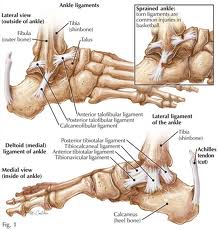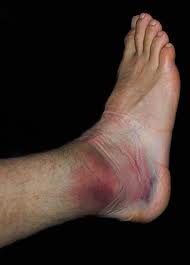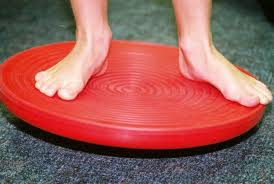Sprained Ankle
- Home
- Ankle
- Common Ailments
- Sprained Ankle
A sprained or twisted ankle is the most common type of soft tissue injury.
Statistics show that over 1.5million people go to A&E with a twisted or sprained ankle.
The ankle or talocrural joint is a saddle joint. This allows the ankle to move up and down, and a small amount of inversion (turning the foot in) and eversion (turning the foot out). The subtalar or talocaloneal joint is the main joint that allows the ankle to in and evert. The ankle joint is support from both the medial (inside) and lateral (outside) aspects by ligaments.
The 3 lateral ligaments are named independently. They attach bone to bone and are well spaced and relatively narrow. As a result they are commonly sprained (overstretched) with the action of inversion (turning the foot in).
The medial ligaments are collectively known as the ‘deltoid ligament’. These ligaments are close together and broad, as a result they are generally strong and withstand most strain put upon them.

The most common cause of an ankle sprain is when the foot turns inwards (inverts) and the lateral ligaments are overstretched, or even worse are torn or ruptured. The deltoid ligament can also be sprained by the actiono f the foot turning outwards (eversion), however this is less common. What is more likely to happen is, when the foot inverts and the lateral ligaments are damaged the deltoid ligament becomes compressed. This can cause local damage to the medial complex.
Ligament sprains are most commonly associated with sporting injuries where the ankle ‘gives way’ due to a sharp change in direction, uneven surface or when the foot is caught underneath.
Other causes include:
- Falling over in high heels
- Slipping off a step or kerb
- Landing awkwardly, or mis-planting the foot when walking or running
Ligament sprains are graded 1-3:
- Grade I – minor. This occurs when the ligament is stretches and the symptoms are usually limited to pain and local swelling. You can often walk without crutches, but may not be able to jog or jump.
- Grade II – moderate tear. This occurs when the ligament is subjected to partial tearing. Symptoms include more significant swelling that can be widespread around the ankle. Bruising also occurs due to bleeding under the skin. Patients can also have pain when walking and will need help from crutches
- Grade III – rupture. This occurs when the ligament(s) completely tear. The ankle becomes significantly swollen, is very pain and bruised. Walking is very difficult due to the pain, and patients may also complain of instability or a giving way sensation.
To summarise, the symptoms of a ligament sprain are:
- Pain
- Swelling – this normally occurs local to the ligament sprained and in more serious cases can spread around the ankle, into the foot and toes or spread up the lower leg.
- Bruising
- Heat
- Instability or a sensation of giving way

Grade I and II ligament sprains are normally treated conservatively, and although Grade III sprains can be treated conservatively they often require further invention, this often involves surgery.
- Pain relief in the form of paracetamol is advised to help control the pain. Additionally anti-inflammatories may also be beneficial to help with the swelling control in addition to pain relief (always seek advice from you pharmacist or GP before taking medication)
- Swelling control is important that the swelling is under control ASAP. Ice and compression to the swollen area will help reduce swelling. Elevation is recommended and basic foot pumps (moving the ankle backwards and forwards) will also help to settle the swelling (please refer to our guidelines on PRICE for a more detailed explanation on acute management)
- Crutches – Grade II and III ligament sprains may require the use of crutches to help offload the weight that would be transferred through the affected ankle. Crutches will also help to keep you mobile
- Physiotherapy is highly recommended for all grades of ligament sprains. Physiotherapy is useful for advising on the correct management with swelling and pain control. Your therapist can also give you a structured exercise programme to help regain movement, strength, balance and proprioception. We can also help make sure that you are fit enough to return to your chosen sport, educate you on the importance of injury re-occurrence or prevention, and advise on ankle supports if necessary.
- Surgery – for severe cases of Grade III ligament sprains surgery may be advised to repair the ruptured ligament(s). Following surgery, and under the guidelines of the consultant, you will undergo a rigorous physiotherapy rehab programme to ensure that you make a full recovery.
It is important to remember that ligament sprains need care and attention. Physiotherapy plays a vital part in recovery and is important for future management to ensure that the ankle is strong enough to withstand future activities and events.

